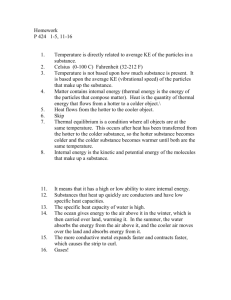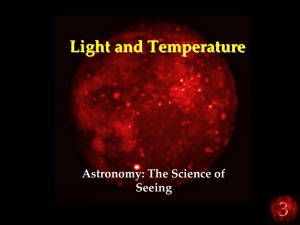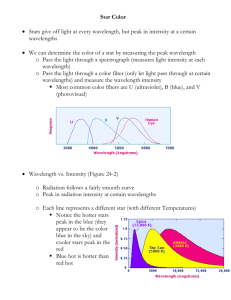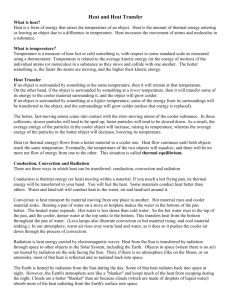Light and Temperature - University of Redlands
advertisement
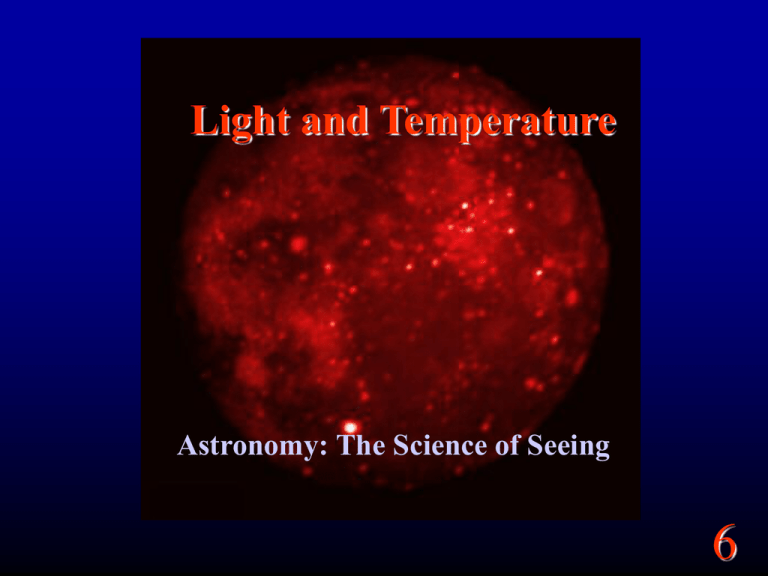
Light and Temperature Astronomy: The Science of Seeing 6 Goals • • • • • What is light? What are the types of light? Where does the light we see come from? Understanding the light of heat. On a sunny day: – Why does it seem hotter wearing a black T-shirt versus a white one? – Why are they different? 6 What is Light? • Light is a wave of energy. • Moves through a vacuum. • Travels at the speed of light (a CONSTANT): c = 3 x 1010 cm/s • The wavelength (l) and frequency (n) are related: c = ln • The energy of light is: E = hn = hc/l 6 The “Visible” Spectrum • When you think of “light”, what do you think of? 6 6 To Sum Up… • Radio waves, microwaves, rainbows, UV waves, x-rays, etc are ALL forms of light (electromagnetic waves). • They ALL travel through space at the speed of light. c • The higher the frequency, the shorter the wavelength. c = ln • The higher the frequency the more energy. E = hn 6 Concept Test • Yellow light has a longer wavelength than blue light. Therefore yellow light has: a. b. c. d. e. A higher frequency and higher energy than blue light. A higher energy and lower frequency than blue light. A lower frequency and lower energy than blue light. A lower energy and higher frequency than blue light. None of the above. 6 A Spectrum Emission lines Continuum Absorption lines • A spectrum = the amount of light given off by an object at a range of wavelengths. 6 Three Reasons All objects do one or more: 1. Reflect light because of color or smoothness (same as scatter) 2. Emit light because of their temperature (thermal radiation) 3. Emit or absorb light because of their composition (spectral lines) A person, house, or the Moon: reflects visible light, and because each is warm, emits infrared light. 6 Temperature and Light • Warm objects emit light. – Thermal radiation 6 Kelvin Temperature • • • • • • Kelvin: an absolute scale. Kelvin is Celsius + 273 degrees. Water freezes: 0 C 273 K Water Boils: 100 C 373 K Room Temp: 80 F 27 C 300 K Surface Sun: 5800 K 6 Thermal Radiation Laws 1. Hotter is bluer. – (peak at shorter wavelength) 2. Hotter is brighter. – (More intense at all wavelengths) 6 Concept Test Which of the two stars (A or B) is at a higher temperature? Star A visible range a. Star A b. Star B c. The two stars have the same temperature. d. It is not possible to infer this relationship. Star B VIBGYOR Wavelength 6 Concept Test Which of the following best describes how Star A would appear compared to Star B? a. Star A would appear more red than Star B. b. Both stars would appear more red than blue. c. Both stars would appear more blue than red. d. Star A would appear more blue than Star B. e. None of the above. Star A visible range Star B VIBGYOR Wavelength 6 Atoms in Motion • Everything is composed of atoms which are constantly in motion. 6 Temperature • The hotter the object, the faster the average motion of the atoms. HOTTER COOLER 6 Atoms and Light • As atoms move they collide (interact, accelerate). • Collisions give off energy. • But light IS energy. E = hc/l 6 Light and Temperature • The hotter the object the faster the average atom and the more energetic the average collision. • The faster the atoms the more collisions there are. HOT COLD 6 Energy and Intensity • The more energetic the average collision the bluer the average light that is given off. – Since E = hc/l • The more collisions that occur the more light that is given off per surface area. 1. Hotter is bluer. 2. Hotter is brighter. (peak at shorter wavelength) (more intense at all wavelengths) 6 Thermal Radiation Laws 1. Hotter is bluer. – (peak at shorter wavelength) 2. Hotter is brighter. – (More intense at all wavelengths) 6 Thermal versus Reflection • Thermal radiation is light given off because of an object’s temperature. • Don’t confuse with reflected light: – Buses are yellow not because they are hot enough to emit visible radiation but rather they reflect the yellow light given off by the Sun. • What kinds of thermal radiation do we see in our everyday life? 6 The IR World • Everyday objects (at everyday temperatures) emit thermal radiation in the IR, this is why we equate IR with HEAT. http://www.x20.org/library/thermal/blackbody.htm 6 The IR Universe Orion - visible Orion – by IRAS • Everyday things that are hot radiate in the IR: • Dust – There are interstellar clouds of dust. 6 The IR Universe Io from IRTF. Orion – by IRAS • Molten Rock – There are lava flows on a moon of Jupiter. 6 The IR Universe The Moon in eclipse. Orion – by IRAS R. Gendler • In eclipse, there is no reflected light. • Only thermal radiation. • Differences in composition lead to differences in temperature. 6 Color Why’s • Why is that shirt blue? a. b. c. d. e. It’s hot. It’s cool. It’s hotter than a red shirt. It’s reflecting blue light. It’s absorbing blue light, thus making it blue. 6 Color Why’s • Why is the Sun yellow? a. b. c. d. e. It’s cooler than a blue flower. It’s hotter than a person. It’s reflecting yellow light. It’s absorbing yellow light, thus making it yellow. None of the above. 6 Color Why’s • Why is this paper white? a. It’s temperature. b. It’s hotter than the sun but cooler than a blue shirt. c. It reflects only white wavelengths of light, and absorbs the rest. d. It absorbs white light, thus making it white. e. It reflects all visible light equally. 6 Color Why’s • Why is the light filament orange? a. b. c. d. e. It is hotter than a person, but cooler than the sun. It is cooler than a blue shirt. It reflects orange light. It absorbs orange light, thus making it orange. None of the above. 6 Color Why’s • Why is Mars red? a. b. c. d. e. It’s hot. It’s cool. It’s reflecting red light from the Sun. It’s absorbing red light from the Sun. None of the above. 6 Homework #8 • • • For Monday 22-Sept: Read B5.3 – 5.5 Do B5: Problems 35, 38,57 Consider the four stars (A,B,C,D) of Problem 46 in Chapter B5. Arrange them by speed relative to us (starting with the fastest moving towards us and ending with fastest away). a. b. c. d. e. A, B, C, D B, A, D, C D, C, B, A C, D, A, B None of the above Don’t forget Topic of Confusion. 6
